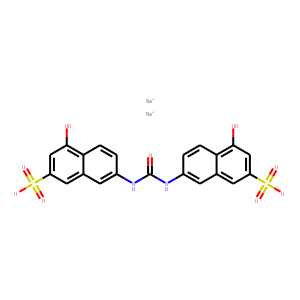| InChI | InChI=1S/C21H16N2O9S2.2Na/c24-19-9-15(33(27,28)29)7-11-5-13(1-3-17(11)19)22-21(26)23-14-2-4-18-12(6-14)8-16(10-20(18)25)34(30,31)32;;/h1-10,24-25H,(H2,22,23,26)(H,27,28,29)(H,30,31,32);;/q;2*+1/p-2 |
| Reference | 1. ChemMedChem. 2010 Mar 1;5(3):398-414. doi: 10.1002/cmdc.200900459.
<br>
Design, synthesis and biological evaluation of carboxy analogues of arginine
methyltransferase inhibitor 1 (AMI-1).
<br>
Castellano S(1), Milite C, Ragno R, Simeoni S, Mai A, Limongelli V, Novellino E,
Bauer I, Brosch G, Spannhoff A, Cheng D, Bedford MT, Sbardella G.
<br>
Author information: <br>
(1)Dipartimento di Scienze Farmaceutiche, Università degli Studi di Salerno, Via
Ponte Don Melillo, 84084 Fisciano SA, Italy.
<br>
Here we report the synthesis of a number of compounds structurally related to
arginine methyltransferase inhibitor 1 (AMI-1). The structural alterations that
we made included: 1) the substitution of the sulfonic groups with the
bioisosteric carboxylic groups; 2) the replacement of the ureidic function with a
bis-amidic moiety; 3) the introduction of a N-containing basic moiety; and 4) the
positional isomerization of the aminohydroxynaphthoic moiety. We have assessed
the biological activity of these compounds against a panel of arginine
methyltransferases (fungal RmtA, hPRMT1, hCARM1, hPRMT3, hPRMT6) and a lysine
methyltransferase (SET7/9) using histone and nonhistone proteins as substrates.
Molecular modeling studies for a deep binding-mode analysis of test compounds
were also performed. The bis-carboxylic acid derivatives 1 b and 7 b emerged as
the most effective PRMT inhibitors, both in vitro and in vivo, being comparable
or even better than the reference compound (AMI-1) and practically inactive
against the lysine methyltransferase SET7/9.
<br>
2. Mol Pharmacol. 2010 Feb;77(2):280-7. doi: 10.1124/mol.109.061077. Epub 2009 Nov
10.
<br>
An inhibitor of protein arginine methyltransferases,
7,7/’-carbonylbis(azanediyl)bis(4-hydroxynaphthalene-2-sulfonic acid (AMI-1), is a
potent scavenger of NADPH-oxidase-derived superoxide.
<br>
Chen F(1), Fulton DJ.
<br>
Author information: <br>
(1)Department of Pharmacology, Medical College of Georgia, Augusta, GA 30912,
USA.
<br>
The methylation of proteins is an important post-translational mechanism that has
been established to influence the activity of nuclear and nucleic acid binding
proteins. Much less is known about the importance of protein methylation in the
regulation of cytosolic proteins. Increased methylation of proteins is observed
in cardiovascular disease and occurs in conjunction with elevated production of
reactive oxygen species. However, the nature of the relationship between reactive
oxygen species and protein methylation is poorly understood. Therefore, the goal
of the current study was to determine whether protein methylation influences the
catalytic activity of the NADPH oxidases (Nox), which are a family of enzymes
responsible for the generation of superoxide. We found that the selective
inhibitor of protein arginine methyltransferases
7,7/’-carbonylbis(azanediyl)bis(4-hydroxynaphthalene-2-sulfonic acid (AMI-1) was a
potent antagonist of Nox-derived superoxide production. However, structurally and
mechanistically dissimilar inhibitors of protein methylation and coexpression of
protein arginine methyltransferase 1 did not influence Nox activity. Rather, the
effect of AMI-1 was rapidly reversible and could be demonstrated in an assay
using chemically synthesized superoxide. We conclude that protein methylation
does not regulate the activity of NADPH-oxidases and that AMI-1 is a potent
antioxidant with a greater potency than 4,5-dihydroxy-1,3-benzenedisulfonic acid
(Tiron) and 4-hydroxy-2,2,6,6-tetramethylpiperydine-1-oxyl (Tempol).
<br>
|

